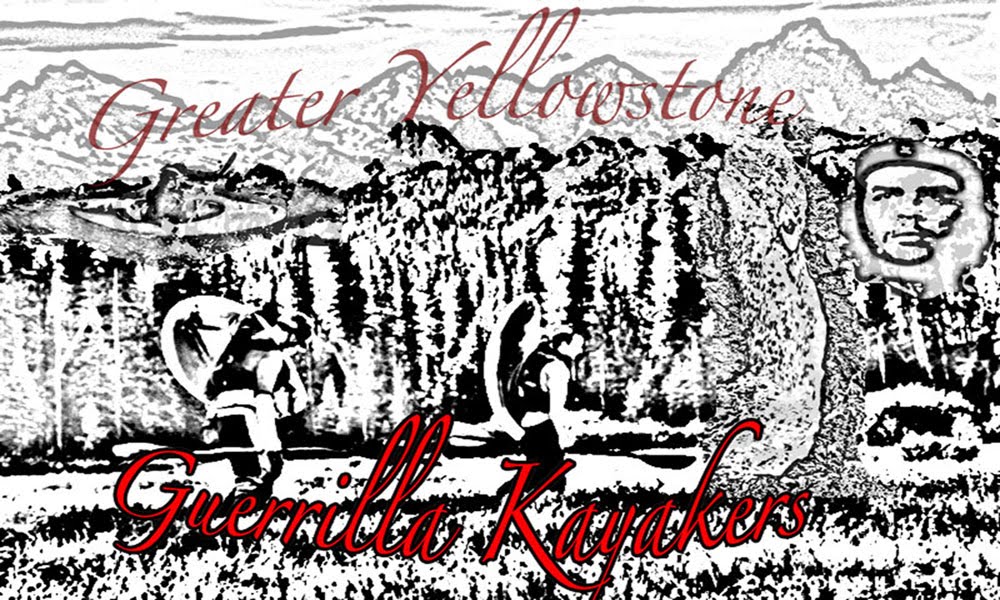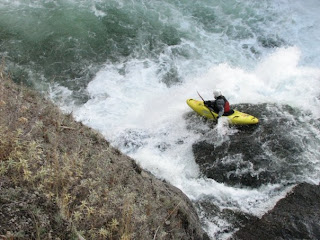I awoke to a light drizzle, cool temperatures and overcast skies. I rolled over and went back to sleep.
I awoke for a second time. This time, I knew it was much later in the day. How late I couldn't tell, but I felt it might be time to get up and see if anyone else was moving around yet. They weren't. I attempted several times to start a fire, but wet wood made for a challenge and I just settled for making coffee and oatmeal with the backpacking stove we'd brought for occasions just like this. Pat and Scott emerged not long after I did and joined me for a hot breakfast and hot coffee.
My accomodations at Camp 2
After breakfast the rain had subsided slightly, and we packed our stuff and got on the river at 2:30 in the afternoon. Not exactly early risers! We paddled hard and made it to a sight we'd been waiting to see almost as badly as the canyon itself, Mt. Blackadar. Mt. Blackadar appears, a long time before you actually reach it. We spent an hour pumping our fists and whooping loudly as we approached it's base.
Mt. Blackadar hidden in the clouds
After reaching the base, we found a unique eddy with a rock spire directly below Mt. Blackadar. Pat and I climbed the spire and began eating our lunch at the base of the great mountain, while Scott ran up the opposite shore searching for the perfect photograph of the mountain. Other than just being stoked to see Mt. Blackadar in all it's glory, this also symbolized that we were very close to Turnback Canyon, as it lay just on the opposite side of the mountain .
The three of us arrived at the Tweedsmuir Glacier and Turnback Canyon no more than two hours after finishing our lunches. The river above the Glacier is incredibly wide and already beginning to show characteristics of a lake. A lake that could be formed by the Tweedsmuir Glacier blocking the river above Turnback Canyon. At the time of our trip, the Tweedsmuir was within 200 feet of accomplishing just that.
As we approached the campsite above Turnback we saw large towering walls of Ice, and just downstream we could see what looked to be the entrance of the canyon!
We arrived to find two raft-groups camped out and waiting for a helicopter to portage them around the canyon. For us, this meant a few extra luxuries for the next day or two. We set our camp between the two raft parties and immediately walked downstream to check out the glacier.
We walked to the top of a small dome directly across from the glacier and sat down to observe. What we saw was a phenomenon of nature that blew my mind. The glacier would calve large pieces of ice into the river at an amazing rate. At times we witnessed 200' tall chunks of ice crash into the river and send tidal-waves racing upstream. And Ice-bergs floating downstream into Turnback Canyon.
The Tweedsmuir above Turnback and the river of ice flowing downstream
We enjoyed a feast that night, as we ate our regular meals which were then supplemented with the raft companies leftovers. Bellies full and bodies exhausted, Pat again read us an excerpt from Never Turnback, and we all went to sleep ready to scout the canyon's entrance on foot the next day.
Day 4
The entire night we were awakened every so-often by the glaciers thundering bursts. It made for one of the most restless night's sleep of my life, and one I would not trade for anything.
We ventured to the canyon's mouth shortly after eating breakfast. The hike took us around forty-five minutes from camp and involved crossing some incredibly beautiful terrain. To one side we had Mt.Blackadar and all it's glory and to the other we had the Alsek River and the Tweedsmuir Glacier. About half-way through the hike, we stopped to watch the glacier for a moment and witnessed the glacier calve several times, though they were all very small. After a snack we continued on our short trek. Only moments after walking away from our snack-point, we heard a thundering roar and turned to see the glacier calving an enormous piece of ice into the river. Chunks of ice shot through the air and covered our previous overlook before a tidal wave came roaring across the river and soaked that same location. We had been sitting their only minutes before and assuredly would have been subjected to the wrath of both water and ice. I was very glad we had moved when we did.
A large calving of the Tweedsmuir Glacier
Soon we came to the entrance rapid and were able to stare into the depths of Turnback Canyon. I remember a feeling of amazement and terror as I saw what we would have to deal with if we chose to run the canyon.
A river of ice was coming down from the Tweedsmuir upstream and this made things interesting. The entrance rapid itself looked manageable. It consisted of a 45 degree bend in the river. From our perspective on the inside corner (river left) we saw large haystack waves and boils all dotted with chunks of ice. The line was wide and even if ice were to hit a kayak I think it would have been manageable in this rapid. Directly downstream however was a different story.
Pat and I scouting the entrance to Turnback
The S-Turns lay directly below a short pool after you enter the canyon. This pool was moving quickly and looked like a minefield dotted with small chunks of ice on the top. Every so-often a large chunk of ice (some the size of small homes) would come rocketing out of the water below having been submerged by the whirlpools and boils in the entrance rapid. With ice moving at high-speeds into the S-Turns, I felt a knot in my stomach begin to form and thought to myself, "We're not going to get to run this canyon, are we?"
Looking downstream into the S-Turns
The S-Turns are a series of bends in the river linked directly together and completely walled in by 100' walls. The resulting features are slightly terrifying but avoidable. Even with the added hazards of ice the line would be to stay on the outside of the turns and avoid the giant boils forming on the inside corners that would most definitely swallow a kayak and subject it to the possibility of an encounter with a not-so-friendly piece of ice. In my head I could see the line and believed I could work things out and make it through the S-Turns.
As we walked back to camp our group was silent. We had all talked prevalently at the canyon mouth about possible lines and consequences but now it seemed we were all deep in thought weighing the pro's and con's of what we'd seen.
Scott and the paddle Walt Blackadar used when he first ran Turnback
Back at camp the rafters were full of questions as to if we were going to attempt the canyon or not. All we could say was we didn't know yet. What we had seen was a small portion of the canyon and the largest rapids remained downstream. The brutal facts were the river level was high (Between 40 and 50,000 CFS over the 5 days we spent on the river) and the Tweedsmuir was surging at an even more dramatic rate than it had when Blackadar had been here. These facts made me think of a quote Blackadar made in a Sports Illustrated article, "Read my words well and don't be a fool. It's un-paddleable." Blackadar of course made it through the canyon, proving it WAS paddleable. His words however reflect the feeling out of control feeling Blackadar experienced and how he always considered himself lucky to have flushed through the canyon alive. He did not believe he succesfully navigated the canyon.
I went to sleep on the night of the 7th thinking about the one decision that would ultimately be a decision of life and death.
Day 5
I slept restlessly. I couldn't get the canyon out of my mind. I wanted to run it. I wanted to run it so badly that I had spent the night convincing myself I could do it. I knew full well that I might ultimately opt-out of the descent, but personally if I don't have myself fully committed before I scout something I leave too many variables in my mind for fear to feed upon. Therefore when I stepped into that yellow Bell Helicopter on July 8th, 2008, I knew I was going to run Turnback Canyon.
Mackonen arrived shortly after breakfast and shuttled the rafters to the far end of the canyon. We said goodbye and listened to their words of encouragement and fear for us, all the while wishing us well and hoping we would make a safe decision.
Mackonen coming in for a landing!
As we sped through the canyon Scott, Pat and myself were in Awe of the size and power of some of the rapids. After the S-Turns most everything looked manageable up until we reached a river-wide ledge-hole. Two lines presented themselves here and neither looked appealing, but both looked doable. One option was to run hard left and hope the curling edge of the hole didn't suck you backwards into the ledge. The second option was to line up and run down the middle. At first glance, the hole looked impenetrable, but a trained eye could see that a small V formed in the middle of the hole and water was pushing out here, allowing the possibility of punching through. The negatives to both lines were that a piece of ice could easily push you off course here and ruin your day or more likely, your life.
The ledge-hole
"I'm out." I heard Scott's voice over the headset. I remained silent, as did Pat. We continued downstream and quickly came to the crux of the run. We saw a rapid so big and terrifying it made my mind go blank in amazement. The river dropped significantly here forming a steep rapid filled with gigantic crashing waves and giant boils coming off both banks. Some of the waves were straight and some were diagonal. There was no rhyme or reason to the formations and occasionally waves would crash together exploding ice into the air. This was the rapid Blackadar described as "Hair".
We sped past Hair and on down the canyon. Things mellowed out quickly from here and I was fully confident I could run everything in Turnback canyon, except for Hair.
HAIR
"I'm Out." This time it was my voice over the radio leaving only Pat silent and stoic in the front seat. He wanted this bad.
Pat still considering the canyon left me in a tough spot. I couldn't let him go alone. Safety in Turnback is an illusion, however if there were a chance for rescue it could only come from a fellow boater. Pat and I had experienced alot together on and off the river throughout our friendship and if he thought the canyon was doable, I would have gladly gone to battle with him.
"I'm Out." Pat's voice was deep and forceful. It was obvious he had just processed an internal war of emotion. Although it was the right call and the safe call, you could tell it didn't sit well with Pat. I felt a sense of relief hearing him say that and leaned forward and gave his shoulders a quick squeeze. Scott, Pat and myself, three brothers, would all be returning home to tell the tale of what we'd seen. Mr. Blackadar, we salute you.
Austin R. Ready to go home
Pat Keller all smiles on the flight out
Scott Harcke, The Man





































